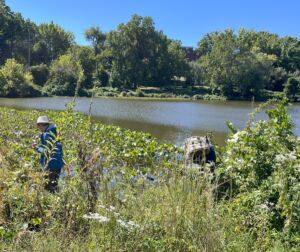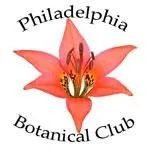Submitted by Karl Anderson, karlanderson6@aol.com
The weather was perfect on this Sunday morning, as members of the Philadelphia Botanical Club joined the leader for an informal 600-meter linear survey, aggregating to less than one-tenth of an acre, of the plant life around the perimeter of a small suburban shopping mall and a recent construction zone. We were rewarded by finding 109 species of vascular plants of which 52 were annuals, 34 were perennials, and 23 were woody plants or woody vines. Of the 52 annuals, 31 were non-native. Of the 34 perennials, 16 were non-native. Of the 23 woody plants, 13 were non-native. Of the 109 total species, 60 were non-native. Few of the plants we saw during our walk were unfamiliar to the seasoned field botanists of our group, but Calibrachoa parviflora, a late nineteenth century ballast dump plant which has reappeared in New Jersey three times, in different locations, in recent years, was an exception. After completing our walk and a brief rest, we braved thickets of Ampelopsis heterophylla and Clematis terniflora to reach the shores of Broad Street Lake, where a quick look around produced 55 species of which 14 were annuals, 25 were perennials, and 16 were woody plants or woody vines. Of the 55 total lakeshore species, 17 were non-native. This trip amply demonstrated both the adaptability of native and introduced plants, and the botanical diversity of a site that might otherwise have been dismissed as uninteresting.
Even 207 years ago, many of the non-native plants we found would have been familiar to William P. C. Barton, who was then writing his Compendium Florae Philadelphicae. Such would have included Mollugo verticillata, Digitaria sanguinalis, Portulaca oleracea, Sida spinosa, and Persicaria maculosa. But Diodia virginiana, Cyperus iria, Arthraxon hispidus, and even Lonicera japonica would have been new to him. The town of Woodbury is mentioned 73 times in the Compendium, which, covering “plants found within a circuit of ten miles around Philadelphia,” includes a large area in New Jersey. Barton used the town as a seasonal base of operations.
Barton would have arrived in New Jersey via the ferry from Philadelphia to Kaighn’s Point. Taking the Woodbury Road south for seven miles, he would have noticed our trip site which was then a wet meadow bordering Woodbury Creek, still tidal at three miles from its mouth. (Here is a current map of the survey site.) A few hundred yards farther south was the Friends Meeting House, constructed in 1715. (Click here to learn about Woodbury Friends). And another hundred yards south was two-story Wilkin’s Inn, the northernmost of three hostelries in the town. What else could he have needed? Barton was a surgeon (a more general term then than now) in the United States Navy, but in his era much of medicine derived from plants and in 1815 at the age of 27 he became the Professor of Medical Botany at the University of Pennsylvania. The Compendium grew out of Barton’s need to provide a “field guide” for his students to use during their excursions with his class into the environs of Philadelphia.




